- Details
- Hits: 1281
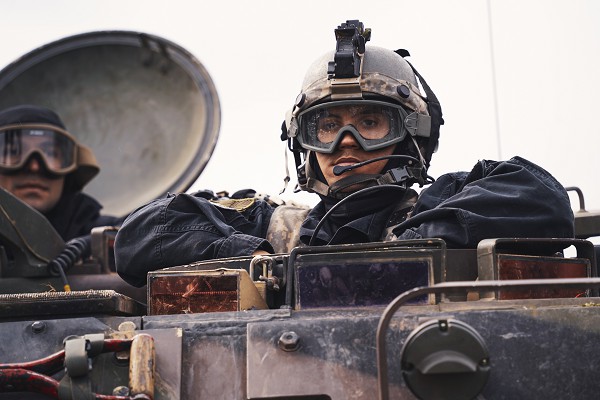 Hohenfels Training Area, Germany. (November 15, 2022): In this photo by Sergeant LaShic Patterson, U.S. soldiers assigned to the Joint Multinational Readiness Center play the opposing force during Dragoon Exercises conducted by the 7th Army Training Command.
Hohenfels Training Area, Germany. (November 15, 2022): In this photo by Sergeant LaShic Patterson, U.S. soldiers assigned to the Joint Multinational Readiness Center play the opposing force during Dragoon Exercises conducted by the 7th Army Training Command.
Hohenfels Training Area, Germany. (November 15, 2022): Help Wanted. Candidate must be young, in top physical condition, be willing to travel, and not afraid of cramped spaces.
Oh, and did we mention, you’ll be riding America’s premier war machine?
That is the life of a U.S. Army Armor crewmember manning the M1A2 Abrams main battle tank in combat. It’s a job that requires physical courage, stamina, and the ability to make split second decisions under extreme stress.
It’s not a job for just anyone.
Today’s Armor crews consist of a driver, a loader, a gunner, and a tank commander all working together like a symphony orchestra to locate and destroy the enemy. Unlike those who came before them, today’s tankers must not only be physically strong but also technically proficient as they deal with some of the most sophisticated equipment in the Army.
Prospective Armor Crewmembers begin their careers at the home of the infantry, Ft. Benning, Georgia, where they receive 22 weeks of both basic and advanced training. Here they learn the basics; map reading and land navigation, communications, scouting, and how to execute military battle plans. In the field, candidates learn to load and fire the Abram’s massive 120 mm main gun while practicing offensive and defensive maneuvers under simulated combat conditions. The duties of a four-person tank crew are as follows:
The Loader
This is the lowest ranking job on a tank crew but arguably the most critical to the performance, and survival, of the entire team. It is tough, physical work requiring a strong back and nimble hands to quickly load a variety of munitions under the extreme pressure of combat.
The Driver
The driver compartment is a cramped space in front of the tank’s hull, directly under the main gun, in a form fitting bucket seat that tank drivers say it is like riding in a very comfortable recliner. They drive the tank using motorcycle style handlebars using a twist grip throttle to accelerate or decelerate and the brake pedals are on the floor just like a car. The “dashboard” consists of an integrated display with three periscopes (called vision blocks) and it includes highly sophisticated night vision sensors. The Driver responds to commands from the Tank Commander riding above him who has a better view of the battlefield.
- Details
- Hits: 1297
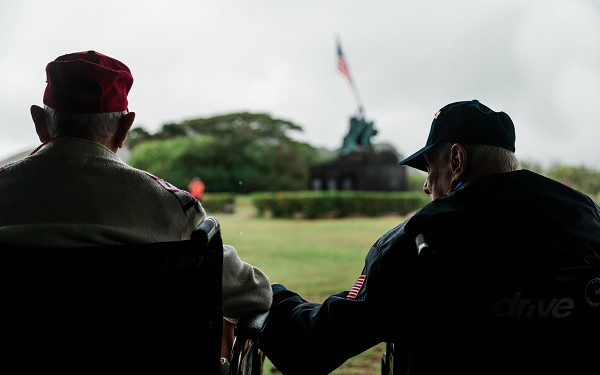 Marine Corps Base Hawaii. (November 10, 2022): U.S. World War II veterans sit together at the Iwo Jima Memorial, Hawaii, as Marines with the 3rd Battalion, 3rd Marines gather to express their gratitude to the more than 63 Iwo Jima veterans on the 80th anniversary of the attack on Pearl Harbor.
Marine Corps Base Hawaii. (November 10, 2022): U.S. World War II veterans sit together at the Iwo Jima Memorial, Hawaii, as Marines with the 3rd Battalion, 3rd Marines gather to express their gratitude to the more than 63 Iwo Jima veterans on the 80th anniversary of the attack on Pearl Harbor.
Marine Corps Base Hawaii. (November 10, 2022): It has been 80 years since they stormed the beaches of Iwo Jima in one of the bloodiest battles in Marine Corps history. Over 70,000 Marines took on approximately 18,000 Japanese soldiers in the thirty-six-day battle in which 7,000 Marines were killed and another 20,000 wounded.
The Marines captured just 216 Japanese; the rest were killed in action.
Above are Marine survivors of the battle being honored by today’s Marines as they gaze at a monument to their courage and sacrifice. As the years pass, there will be fewer and fewer of these precious veterans to honor but their memory will live forever.
At Support Our Troops, our mission is to sustain our current crop of heroes, particularly servicemembers who are deployed overseas. We are issuing a national call to all good Americans to show their love and support for our deployed troops this holiday season by joining Support Our Troops' efforts to ship Yellow Ribbon Thanksgiving and Christmas Care Packages to our troops overseas.
Read more: Salute To WWII Vets… MARINES WHO FOUGHT AT IWO JIMA HONORED IN HAWAII
- Details
- Hits: 1274
“Where water is, Sailors will go.
Admiral Horacio Rivero, USN
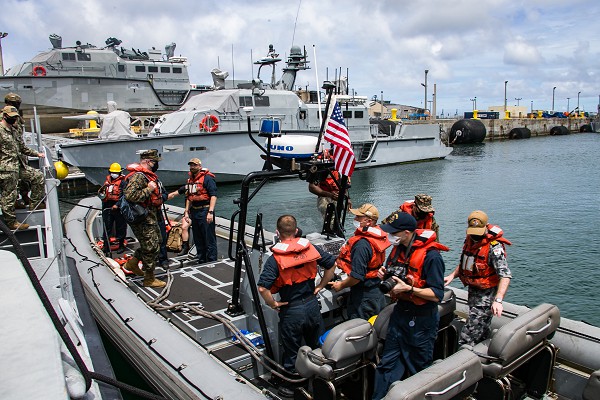
Naval Base Guam (November 2, 2020): In 1968, American forces in Vietnam were confronted with an indigenous guerrilla force that blended into and enjoyed the support of the local population. Of particular concern was Viet Cong activity in the vast Mekong Delta, a hot, humid, low-lying area filled with a maze of waterways that acted as interstate highways for the enemy. Taken together, the Mekong Delta was an extraordinary riverine challenge for the Americans.
The U.S. Navy responded with the largest riverine force since World War II involving hundreds of patrol boats plying the canals and lagoons of the Delta in search of the thousands of Viet Cong guerrillas. The Delta comprised about one fourth of the land mass in Vietnam and was home to over 4 million Vietnamese. Until the Delta was secured, little progress could be made on land.
Read more: MEKONG DELTA A TRUE TEST OF AMERICAN RIVER TACTICS
- Details
- Hits: 1053
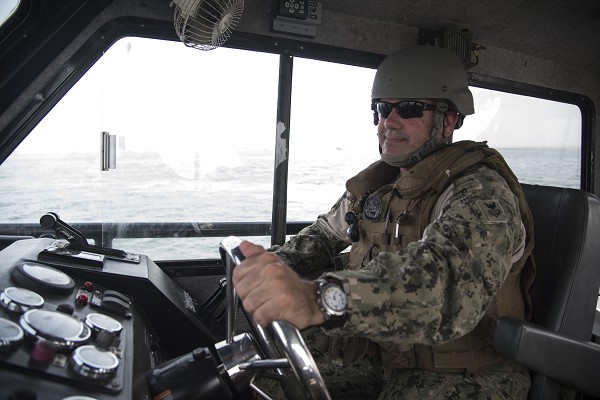 Djibouti. (November 12, 2022): U.S. Navy Petty Officer 1st Class James Padden, a Coastal Riverine Squadron Captain assigned to Combined Joint Task Force Horn of Africa, drives a Sea Ark Dauntless patrol boat, a craft now being shipped to Ukraine to help fight the Russians on the Dnipro River.
Djibouti. (November 12, 2022): U.S. Navy Petty Officer 1st Class James Padden, a Coastal Riverine Squadron Captain assigned to Combined Joint Task Force Horn of Africa, drives a Sea Ark Dauntless patrol boat, a craft now being shipped to Ukraine to help fight the Russians on the Dnipro River.
Djibouti. (November 12, 2022): The Dnipro River drives through the heart of Ukraine, at 1,400 miles it is the fourth largest river in Europe.
For the Russian invaders, it is a natural protective barrier for their beleaguered forces as they retreat from city of Kherson. For the Ukrainians, the Dnipro is an opportunity to press their attacks against the invaders to drive them from their land. Control of the Dnipro, therefore, is vital to victory for both sides.
The United States has been sending Sea Ark Dauntless patrol boats to help the Ukrainians gain the upper hand in this important waterway. The Dauntless Sea Ark, produced by the North Carolina based U.S. Watercraft, is an aluminum vessel with a deep vee hull design that can carry up to seven tons. The Dauntless is standard for U.S. force protection at ports around the world and is a much-needed asset for Ukraine. Its current riverine force, called the Ukraine Navy Dnipro River Squadron, is made up largely of converted fishing and pleasure vessels. The Dauntless offers these embattled forces many new capabilities. These relatively small craft can transport up to 13 troops into battle and it also serves as a weapons platform for the .50 caliber machine gun. Armed and armored, the Dauntless is often used in Special Operations missions due to its range and top speed.
Read more: U.S. SENDING RIVERINE CRAFTS AND KNOWLEDGE TO UKRAINE
- Details
- Hits: 942
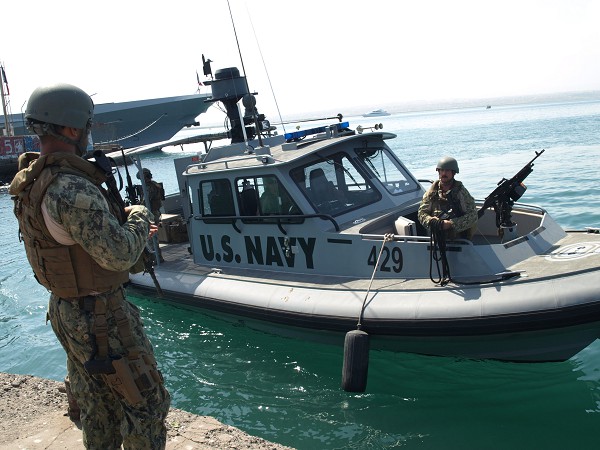 Republic of Djibouti. (November 9, 2022): In this photo by Master-at-Arms 2nd Class Perry Lafoe, Master-at-Arms 3rd Class Xavier Sierra, left, and Engineman 2nd Class Michael Shultz conduct a crew swap in port after a patrol mission. The sailors are assigned to Coastal Riverine Squadron 10 under the U.S. 6th Fleet operating on the horn of Africa. Riverine sailors like these trace their heritage to the American Revolutionary War and none other than Benedict Arnold.
Republic of Djibouti. (November 9, 2022): In this photo by Master-at-Arms 2nd Class Perry Lafoe, Master-at-Arms 3rd Class Xavier Sierra, left, and Engineman 2nd Class Michael Shultz conduct a crew swap in port after a patrol mission. The sailors are assigned to Coastal Riverine Squadron 10 under the U.S. 6th Fleet operating on the horn of Africa. Riverine sailors like these trace their heritage to the American Revolutionary War and none other than Benedict Arnold.
Republic of Djibouti. (November 9, 2022): At the outset of the War of 1812, American commanders, including our nation’s most notorious traitor, learned the British would attempt to split New England from the other colonies by seizing Lake Champlain. Anticipating the threat, none other than General Benedict Arnold led a daring pre-dawn riverine raid against the British garrison defending the St. John. Capturing a 70-ton sloop along with dozens of watercrafts and badly needed cannon and munitions, Arnold managed to stave off a British invasion.
This was one of the first of many riverine (of or related to rivers or shallow coastal waters) engagements by American forces to secure the American colonies northern flank against a well-equipped British Navy. For the outnumbered Americans, lakes and rivers would prove a challenging and costly environment to make war.
The American riverine warriors pictured above are part of the U.S. Navy’s law enforcement and force protection program to protect U.S. warships in port. Coastal Riverine Squadron 10, based in Jacksonville, Florida, is tasked with protecting critical assets and supplies coming in and out of foreign and U.S. ports. Squadron 10 provides expeditionary detachments to the U.S. 6th Fleet based in Naples, Italy whose tactical responsibility includes both the European and African theaters. Typically, these sailors deploy for eight months to ports, like Djibouti, where terrorists threaten U.S. Navy vessels. Part law enforcement and part small ship’s captain, a riverine operator is trained to interdict drug smugglers and human traffickers while guarding American lives from terrorist attack.
In the Navy, the military police function is the Master-at-Arms, responsible for base security, force protection, and other law enforcement duties on land and at sea. Candidates must pass a rigorous 9-week course at San Antonio, Texas, and then deploy to a squadron around the world. Duties of a Master-at-Arms vary widely from traditional base security patrols to detecting explosives as part of a K-9 team. It is one of the most interesting and challenging jobs in the Navy.
For two centuries, American servicemembers have patrolled the dangerous waters of the world to keep us safe. There are thousands of sailors, like these, on duty right now far from home as the holidays approach. Won’t you take a moment to help us send a little comfort their way for the holidays? You can join the thousands of Americans who make monthly contributions to Support Our Troops' Patriots Brigade® which provides comfort items and recreational activities for our troops, particularly those deployed overseas. Please visit our secure website https://supportourtroops.org/donate to donate to America’s finest today!
- Details
- Hits: 1206
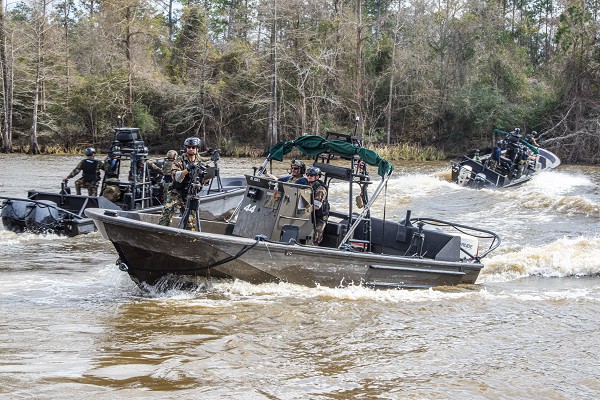 Stennis Space Center, MS. (February 22, 2022): In this photo by Michael Williams, Naval Small Craft Instruction and Technical Training School students from Estonia, Germany, Poland, and Romania participate in a Patrol Craft Officer Riverine training exercise on the Pearl River, Mississippi. This seven-week course is designed to provide international students with the knowledge and skills to operate a riverine patrol craft. To date, the school has trained more than 13,000 students from 120 partner nations.
Stennis Space Center, MS. (February 22, 2022): In this photo by Michael Williams, Naval Small Craft Instruction and Technical Training School students from Estonia, Germany, Poland, and Romania participate in a Patrol Craft Officer Riverine training exercise on the Pearl River, Mississippi. This seven-week course is designed to provide international students with the knowledge and skills to operate a riverine patrol craft. To date, the school has trained more than 13,000 students from 120 partner nations.
Stennis Space Center, MS. (February 22, 2022): To the military, rivers and streams are not an obstacle to overcome but an opportunity for victory. The riverine environment, which includes both inland and shallow water coastlines, has provided natural routes for transportation and communication among communities for centuries. In combat, the force that controls these waterways enjoys a major tactical advantage. These waterways are equally valuable to special operations forces as ideal avenues for insertion or escape.
The Naval Small Craft Instruction and Technical Training School was established in 1961 at what is now the John C. Stennis Space Center, named in honor of U.S. Sen. John C. Stennis for his staunch support of the nation's space program. The site was originally a static test facility for launch vehicles to be used in the Apollo manned lunar landing program. Less than eight years later, astronauts Neil Armstrong and Buzz Aldrin walked on the lunar surface, safely transported thousands of miles by a space vehicle whose boosters were tested and proven flight-worthy at Stennis Space Center. In a testament to the workers at Stennis, all the Apollo space vehicle boosters did their job without a single failure, including those for the Apollo 11 mission landing of the first men on the moon.
Read more: INTERNATIONAL STUDENTS TRAIN IN RIVERINE OPERATIONS
- VETERAN OWNED MACK BELTS™ PARTNERS WITH Support Our Troops®
- Most “Unappreciated” At Thanksgiving? MILITARY COOKS DO THEIR BEST… STILL GET THE GRIEF
- Taking Time To Give... COAST GUARD DEPLOYS TO BRIGHTEN CHILDREN’S HOLIDAYS
- For Servicemembers... MILITARY CLERGY TREAT LONELINESS AND THE SOUL
- A DIFFERENT KIND OF FAMILY
- This Veterans Day…


